All-Optical Modulation Technology Based on 2D Layered Materials
Abstract
:1. Introduction
2. Two-Dimensional Materials
2.1. Types of 2D Materials and Their Characteristics
2.1.1. Graphene
2.1.2. Topological Insulators (TIs)
2.1.3. MXenes
2.1.4. Transition Metal Dichalcogenides (TMDs)
2.1.5. Black Phosphorous (BP)
2.2. Fabrication of 2D Materials
2.2.1. Top-Down Approaches (Exfoliation from Bulk)
2.2.2. Bottom-Up Approach
3. Working Principles and Types of Optical Modulator
3.1. Saturable Absorption
3.2. Kerr Effect
3.3. Thermo-Optic Effect
4. Conclusions and Future Perspectives
- (1)
- Explore new heterostructures hybrid systems;
- (2)
- Explore new tailoring mechanism between 2D materials with nano-plasmonic;
- (3)
- Explore the new application of optical or magnetically effect;
- (4)
- Explore the physical mechanism of 2D materials anisotropy.
Author Contributions
Funding
Conflicts of Interest
References
- Schaller, R.R. Moore’s law: Past, present and future. IEEE Spectr. 1997, 34, 52–59. [Google Scholar] [CrossRef]
- Yang, S.; Liu, D.C.; Tan, Z.L.; Liu, K.; Zhu, Z.H.; Qin, S.Q. CMOS-compatible WS2-based all-optical modulator. ACS Photonics 2018, 5, 342–346. [Google Scholar] [CrossRef]
- Shen, Y.-R. The Principles of Nonlinear Optics; Wiley-Interscience: New York, NY, USA, 1984. [Google Scholar]
- Geim, A.K.; Grigorieva, I.V. Van der Waals heterostructures. Nature 2013, 499, 419–425. [Google Scholar] [CrossRef] [PubMed]
- Bhimanapati, G.R.; Lin, Z.; Meunier, V.; Jung, Y.; Cha, J.; Das, S.; Xiao, D.; Son, Y.; Strano, M.S.; Cooper, V.R. Recent advances in two-dimensional materials beyond graphene. ACS Nano 2015, 9, 11509–11539. [Google Scholar] [CrossRef] [PubMed]
- Kaul, A.B. Two-dimensional layered materials: Structure, properties, and prospects for device applications. J. Mater. Res. 2014, 29, 348–361. [Google Scholar] [CrossRef] [Green Version]
- Novoselov, K.; Neto, A.C. Two-dimensional crystals-based heterostructures: Materials with tailored properties. Phys. Scr. 2012, 2012, 014006. [Google Scholar] [CrossRef]
- Tan, C.; Cao, X.; Wu, X.-J.; He, Q.; Yang, J.; Zhang, X.; Chen, J.; Zhao, W.; Han, S.; Nam, G.-H. Recent advances in ultrathin two-dimensional nanomaterials. Chem. Rev. 2017, 117, 6225–6331. [Google Scholar] [CrossRef]
- Yan, P.; Lin, R.; Chen, H.; Zhang, H.; Liu, A.; Yang, H.; Ruan, S. Topological insulator solution filled in photonic crystal fiber for passive mode-locked fiber laser. IEEE Photonics Technol. Lett. 2014, 27, 264–267. [Google Scholar]
- Mao, D.; Wang, Y.; Ma, C.; Han, L.; Jiang, B.; Gan, X.; Hua, S.; Zhang, W.; Mei, T.; Zhao, J. WS2 mode-locked ultrafast fiber laser. Sci. Rep. 2015, 5, 7965. [Google Scholar] [CrossRef] [Green Version]
- Sun, Z.; Hasan, T.; Torrisi, F.; Popa, D.; Privitera, G.; Wang, F.; Bonaccorso, F.; Basko, D.M.; Ferrari, A.C. Graphene mode-locked ultrafast laser. ACS Nano 2010, 4, 803–810. [Google Scholar] [CrossRef] [Green Version]
- Li, J.; Luo, H.; Zhai, B.; Lu, R.; Guo, Z.; Zhang, H.; Liu, Y. Black phosphorus: A two-dimension saturable absorption material for mid-infrared Q-switched and mode-locked fiber lasers. Sci. Rep. 2016, 6, 30361. [Google Scholar] [CrossRef] [PubMed] [Green Version]
- Wang, Z.; Chen, Y.; Zhao, C.; Zhang, H.; Wen, S. Switchable dual-wavelength synchronously Q-switched erbium-doped fiber laser based on graphene saturable absorber. IEEE Photonics J. 2012, 4, 869–876. [Google Scholar] [CrossRef]
- Chen, Y.; Zhao, C.; Chen, S.; Du, J.; Tang, P.; Jiang, G.; Zhang, H.; Wen, S.; Tang, D. Large energy, wavelength widely tunable, topological insulator Q-switched erbium-doped fiber laser. IEEE J. Sel. Top. Quantum Electron. 2014, 20, 315–322. [Google Scholar] [CrossRef]
- Zhang, H.; Tang, D.; Zhao, L.; Tam, H.Y. Induced solitons formed by cross-polarization coupling in a birefringent cavity fiber laser. Opt. Lett. 2008, 33, 2317–2319. [Google Scholar] [CrossRef] [PubMed] [Green Version]
- Chen, Y.; Wu, M.; Tang, P.; Chen, S.; Du, J.; Jiang, G.; Li, Y.; Zhao, C.; Zhang, H.; Wen, S. The formation of various multi-soliton patterns and noise-like pulse in a fiber laser passively mode-locked by a topological insulator based saturable absorber. Laser Phys. Lett. 2014, 11, 055101. [Google Scholar] [CrossRef]
- Mao, D.; Jiang, B.; Gan, X.; Ma, C.; Chen, Y.; Zhao, C.; Zhang, H.; Zheng, J.; Zhao, J. Soliton fiber laser mode locked with two types of film-based Bi 2 Te 3 saturable absorbers. Photonics Res. 2015, 3, A43–A46. [Google Scholar] [CrossRef]
- Liang, G.; Hu, X.; Yu, X.; Shen, Y.; Li, L.H.; Davies, A.G.; Linfield, E.H.; Liang, H.K.; Zhang, Y.; Yu, S.F. Integrated terahertz graphene modulator with 100% modulation depth. ACS Photonics 2015, 2, 1559–1566. [Google Scholar] [CrossRef]
- Peyskens, F.; Chakraborty, C.; Muneeb, M.; van Thourhout, D.; Englund, D. Integration of single photon emitters in 2D layered materials with a silicon nitride photonic chip. Nat. Commun. 2019, 10, 4435. [Google Scholar] [CrossRef] [PubMed]
- You, J.; Luo, Y.; Yang, J.; Zhang, J.; Yin, K.; Wei, K.; Zheng, X.; Jiang, T. Hybrid/integrated silicon photonics based on 2D materials in optical communication nanosystems. Laser Photonics Rev. 2020, 14, 2000239. [Google Scholar] [CrossRef]
- Bao, Q.; Loh, K.P. Graphene photonics, plasmonics, and broadband optoelectronic devices. ACS Nano 2012, 6, 3677–3694. [Google Scholar] [CrossRef]
- Sun, Z.; Martinez, A.; Wang, F. Optical modulators with 2D layered materials. Nat. Photonics 2016, 10, 227–238. [Google Scholar] [CrossRef] [Green Version]
- Liu, M.; Yin, X.; Ulin-Avila, E.; Geng, B.; Zentgraf, T.; Ju, L.; Wang, F.; Zhang, X. A graphene-based broadband optical modulator. Nature 2011, 474, 64–67. [Google Scholar] [CrossRef] [PubMed]
- Liu, M.; Yin, X.; Zhang, X. Double-layer graphene optical modulator. Nano Lett. 2012, 12, 1482–1485. [Google Scholar] [CrossRef]
- Du, W.; Hao, R.; Li, E.-P. The study of few-layer graphene based Mach−Zehnder modulator. Opt. Commun. 2014, 323, 49–53. [Google Scholar] [CrossRef]
- Xia, F.; Wang, H.; Xiao, D.; Dubey, M.; Ramasubramaniam, A. Two-dimensional material nanophotonics. Nat. Photonics 2014, 8, 899–907. [Google Scholar] [CrossRef]
- Luo, S.; Wang, Y.; Tong, X.; Wang, Z. Graphene-based optical modulators. Nanoscale Res. Lett. 2015, 10, 199. [Google Scholar] [CrossRef] [PubMed] [Green Version]
- Li, W.; Chen, B.; Meng, C.; Fang, W.; Xiao, Y.; Li, X.; Hu, Z.; Xu, Y.; Tong, L.; Wang, H. Ultrafast all-optical graphene modulator. Nano Lett. 2014, 14, 955–959. [Google Scholar] [CrossRef]
- Yu, S.; Wu, X.; Wang, Y.; Guo, X.; Tong, L. 2D materials for optical modulation: Challenges and opportunities. Adv. Mater. 2017, 29, 1606128. [Google Scholar] [CrossRef]
- Wang, Y.; Zhang, F.; Tang, X.; Chen, X.; Chen, Y.; Huang, W.; Liang, Z.; Wu, L.; Ge, Y.; Song, Y. All-optical phosphorene phase modulator with enhanced stability under ambient conditions. Laser Photonics Rev. 2018, 12, 1800016. [Google Scholar] [CrossRef]
- Zheng, J.; Tang, X.; Yang, Z.; Liang, Z.; Chen, Y.; Wang, K.; Song, Y.; Zhang, Y.; Ji, J.; Liu, Y. Few-Layer phosphorene-decorated microfiber for all-optical thresholding and optical modulation. Adv. Opt. Mater. 2017, 5, 1700026. [Google Scholar] [CrossRef]
- Uddin, S.; Debnath, P.C.; Park, K.; Song, Y.-W. Nonlinear black phosphorus for ultrafast optical switching. Sci. Rep. 2017, 7, 43371. [Google Scholar] [CrossRef] [PubMed]
- Song, Y.; Chen, Y.; Jiang, X.; Liang, W.; Wang, K.; Liang, Z.; Ge, Y.; Zhang, F.; Wu, L.; Zheng, J. Nonlinear few-layer antimonene-based all-optical signal processing: Ultrafast optical switching and high-speed wavelength conversion. Adv. Opt. Mater. 2018, 6, 1701287. [Google Scholar] [CrossRef]
- Phare, C.T.; Lee, Y.-H.D.; Cardenas, J.; Lipson, M. Graphene electro-optic modulator with 30 GHz bandwidth. Nat. Photonics 2015, 9, 511–514. [Google Scholar] [CrossRef]
- Iijima, S. Helical microtubules of graphitic carbon. Nature 1991, 354, 56–58. [Google Scholar] [CrossRef]
- Novoselov, K.S.; Geim, A.K.; Morozov, S.V.; Jiang, D.-E.; Zhang, Y.; Dubonos, S.V.; Grigorieva, I.V.; Firsov, A.A. Electric field effect in atomically thin carbon films. Science 2004, 306, 666–669. [Google Scholar] [CrossRef] [Green Version]
- Bolotin, K.I.; Sikes, K.J.; Jiang, Z.; Klima, M.; Fudenberg, G.; Hone, J.; Kim, P.; Stormer, H. Ultrahigh electron mobility in suspended graphene. Solid State Commun. 2008, 146, 351–355. [Google Scholar] [CrossRef] [Green Version]
- Bonaccorso, F.; Sun, Z.; Hasan, T.; Ferrari, A. Graphene photonics and optoelectronics. Nat. Photonics 2010, 4, 611–622. [Google Scholar] [CrossRef] [Green Version]
- Kampfrath, T.; Perfetti, L.; Schapper, F.; Frischkorn, C.; Wolf, M. Strongly coupled optical phonons in the ultrafast dynamics of the electronic energy and current relaxation in graphite. Phys. Rev. Lett. 2005, 95, 187403. [Google Scholar] [CrossRef] [PubMed] [Green Version]
- Li, Z.; Henriksen, E.A.; Jiang, Z.; Hao, Z.; Martin, M.C.; Kim, P.; Stormer, H.L.; Basov, D.N. Dirac charge dynamics in graphene by infrared spectroscopy. Nat. Phys. 2008, 4, 532–535. [Google Scholar] [CrossRef] [Green Version]
- Kim, K.S.; Zhao, Y.; Jang, H.; Lee, S.Y.; Kim, J.M.; Kim, K.S.; Ahn, J.-H.; Kim, P.; Choi, J.-Y.; Hong, B.H. Large-scale pattern growth of graphene films for stretchable transparent electrodes. Nature 2009, 457, 706–710. [Google Scholar] [CrossRef]
- Li, X.; Cai, W.; An, J.; Kim, S.; Nah, J.; Yang, D.; Piner, R.; Velamakanni, A.; Jung, I.; Tutuc, E. Large-area synthesis of high-quality and uniform graphene films on copper foils. Science 2009, 324, 1312–1314. [Google Scholar] [CrossRef] [Green Version]
- Liao, L.; Lin, Y.-C.; Bao, M.; Cheng, R.; Bai, J.; Liu, Y.; Qu, Y.; Wang, K.L.; Huang, Y.; Duan, X. High-speed graphene transistors with a self-aligned nanowire gate. Nature 2010, 467, 305–308. [Google Scholar] [CrossRef]
- Sharma, K.R. Graphene Nanomaterials; Momentum Press: New York, NY, USA, 2014. [Google Scholar]
- Aliofkhazraei, M.; Ali, N.; Milne, W.I.; Ozkan, C.S.; Gervasoni, J.L. Graphene Science Handbook: Electrical and Optical Properties; CRC Press: Boca Raton, FL, USA, 2016. [Google Scholar]
- Elias, D.; Gorbachev, R.V.; Mayorov, A.; Morozov, S.; Zhukov, A.; Blake, P.; Ponomarenko, L.; Grigorieva, I.V.; Novoselov, K.S.; Guinea, F. Dirac cones reshaped by interaction effects in suspended graphene. Nat. Phys. 2011, 7, 701–704. [Google Scholar] [CrossRef]
- Liu, M.; Yin, X.; Wang, F.; Zhang, X. Graphene optical modulator. In Carbon Nanotubes, Graphene, and Associated Devices IV; International Society for Optics and Photonics: Bellingham, WA, USA, 2011; Volume 8101, p. 81010J. [Google Scholar]
- Liu, M.; Zhang, X. Progresses in graphene optical modulator. In CLEO: Science and Innovations; Optical Society of America: Washington, DC, USA, 2012; p. JTu1M.6. [Google Scholar]
- Midrio, M.; Boscolo, S.; Moresco, M.; Romagnoli, M.; de Angelis, C.; Locatelli, A.; Capobianco, A.-D. Graphene–assisted critically–coupled optical ring modulator. Opt. Express 2012, 20, 23144–23155. [Google Scholar] [CrossRef] [PubMed]
- Sensale-Rodriguez, B.; Yan, R.; Kelly, M.M.; Fang, T.; Tahy, K.; Hwang, W.S.; Jena, D.; Liu, L.; Xing, H.G. Broadband graphene terahertz modulators enabled by intraband transitions. Nat. Commun. 2012, 3, 780. [Google Scholar] [CrossRef] [PubMed]
- Hao, R.; Du, W.; Chen, H.; Jin, X.; Yang, L.; Li, E. Ultra-compact optical modulator by graphene induced electro-refraction effect. Appl. Phys. Lett. 2013, 103, 061116. [Google Scholar] [CrossRef]
- Polat, E.O.; Kocabas, C. Broadband optical modulators based on graphene supercapacitors. Nano Lett. 2013, 13, 5851–5857. [Google Scholar] [CrossRef]
- Weis, P.; Garcia-Pomar, J.L.; Höh, M.; Neu, J.; Reinhard, B.; Brodyanski, A.; Rahm, M. Graphene on silicon as optically tuned terahertz modulator. In Proceedings of the 2013 38th International Conference on Infrared, Millimeter, and Terahertz Waves (IRMMW-THz), Mainz, Germany, 1–6 September 2013; pp. 1–2. [Google Scholar]
- Wen, Q.-Y.; Sun, D.-D.; Chen, Z.; Tian, W.; Liu, H.-T.; Yang, Q.-H.; Jing, Y.-L.; Zhang, H.-W. Graphene based ultrafast all-optical terahertz modulator. In Proceedings of the 2013 6th UK, Europe, China Millimeter Waves and THz Technology Workshop (UCMMT), Rome, Italy, 9–11 September 2013; pp. 1–2. [Google Scholar]
- Degl’Innocenti, R.; Jessop, D.S.; Shah, Y.D.; Sibik, J.; Zeitler, A.; Kidambi, P.R.; Hofmann, S.; Beere, H.E.; Ritchie, D.A. Graphene-based optical modulator realized in metamaterial split-ring resonators operating in the THz frequency range. In Proc. SPIE 8985, Terahertz, RF, Millimeter, and Submillimeter-Wave Technology and Applications VII; International Society for Optics and Photonics: Bellingham, WA, USA, 2014; Volume 8985, p. 89851E. [Google Scholar]
- Mohsin, M.; Schall, D.; Otto, M.; Noculak, A.; Neumaier, D.; Kurz, H. Graphene based low insertion loss electro-absorption modulator on SOI waveguide. Opt. Express 2014, 22, 15292–15297. [Google Scholar] [CrossRef]
- Wen, Q.-Y.; Tian, W.; Mao, Q.; Chen, Z.; Liu, W.-W.; Yang, Q.-H.; Sanderson, M.; Zhang, H.-W. Graphene based all-optical spatial terahertz modulator. Sci. Rep. 2014, 4, 7409. [Google Scholar] [CrossRef]
- Chen, J.-H.; Zheng, B.-C.; Shao, G.-H.; Ge, S.-J.; Xu, F.; Lu, Y.-Q. An all-optical modulator based on a stereo graphene–microfiber structure. Light Sci. Appl. 2015, 4, e360. [Google Scholar] [CrossRef]
- Li, H.-J.; Wang, L.-L.; Zhang, H.; Huang, Z.-R.; Sun, B.; Zhai, X.; Wen, S.-C. Graphene-based mid-infrared, tunable, electrically controlled plasmonic filter. Appl. Phys. Express 2014, 7, 024301. [Google Scholar] [CrossRef]
- Gusynin, V.; Sharapov, S.; Carbotte, J. Magneto-optical conductivity in graphene. J. Phys. Condens. Matter 2006, 19, 026222. [Google Scholar] [CrossRef] [Green Version]
- Yu, R.; Pruneri, V.; García de Abajo, F.J. Resonant visible light modulation with graphene. ACS Photonics 2015, 2, 550–558. [Google Scholar] [CrossRef] [Green Version]
- Fan, K.; Suen, J.Y.; Padilla, W.J. Graphene metamaterial spatial light modulator for infrared single pixel imaging. Opt. Express 2017, 25, 25318–25325. [Google Scholar] [CrossRef] [PubMed]
- Lee, C.-C.; Mohr, C.; Bethge, J.; Suzuki, S.; Fermann, M.; Hartl, I.; Schibli, T. Frequency comb stabilization with bandwidth beyond the limit of gain lifetime by an intracavity graphene electro-optic modulator. Opt. Lett. 2012, 37, 3084–3086. [Google Scholar] [CrossRef]
- Baylam, I.; Özharar, S.; Kakenov, N.; Kocabaş, C.; Sennaroğlu, A. Femtosecond pulse generation with voltage-controlled graphene saturable absorbers. In Optical Properties of Graphene; World Scientific: Singapore, 2017; pp. 389–433. [Google Scholar]
- Ren, L.; Zhang, Q.; Yao, J.; Sun, Z.; Kaneko, R.; Yan, Z.; Nanot, S.b.; Jin, Z.; Kawayama, I.; Tonouchi, M. Terahertz and infrared spectroscopy of gated large-area graphene. Nano Lett. 2012, 12, 3711–3715. [Google Scholar] [CrossRef] [PubMed] [Green Version]
- Maeng, I.; Lim, S.; Chae, S.J.; Lee, Y.H.; Choi, H.; Son, J.-H. Gate-controlled nonlinear conductivity of Dirac fermion in graphene field-effect transistors measured by terahertz time-domain spectroscopy. Nano Lett. 2012, 12, 551–555. [Google Scholar] [CrossRef]
- Fan, Y.; Shen, N.H.; Zhang, F.; Wei, Z.; Li, H.; Zhao, Q.; Fu, Q.; Zhang, P.; Koschny, T.; Soukoulis, C.M. Electrically tunable Goos–Hänchen effect with graphene in the terahertz regime. Adv. Opt. Mater. 2016, 4, 1824–1828. [Google Scholar] [CrossRef]
- He, X. Tunable terahertz graphene metamaterials. Carbon 2015, 82, 229–237. [Google Scholar] [CrossRef]
- Miao, Z.; Wu, Q.; Li, X.; He, Q.; Ding, K.; An, Z.; Zhang, Y.; Zhou, L. Widely tunable terahertz phase modulation with gate-controlled graphene metasurfaces. Phys. Rev. X 2015, 5, 041027. [Google Scholar] [CrossRef] [Green Version]
- Tamagnone, M.; Capdevila, S.; Lombardo, A.; Wu, J.; Centeno, A.; Zurutuza, A.; Ionescu, A.M.; Ferrari, A.C.; Mosig, J.R. Graphene reflectarray metasurface for terahertz beam steering and phase modulation. arXiv 2018, arXiv:180602202. [Google Scholar]
- Liu, X.; Chen, Z.; Parrott, E.P.; Ung, B.S.Y.; Xu, J.; Pickwell-MacPherson, E. Graphene based terahertz light modulator in total internal reflection geometry. Adv. Opt. Mater. 2017, 5, 1600697. [Google Scholar] [CrossRef]
- Von Klitzing, K. The quantized Hall effect. Rev. Mod. Phys. 1986, 58, 519. [Google Scholar] [CrossRef]
- Hasan, M.Z.; Kane, C.L. Colloquium: Topological insulators. Rev. Mod. Phys. 2010, 82, 3045. [Google Scholar] [CrossRef] [Green Version]
- Bernevig, B.A.; Hughes, T.L.; Zhang, S.-C. Quantum spin Hall effect and topological phase transition in HgTe quantum wells. Science 2006, 314, 1757–1761. [Google Scholar] [CrossRef] [Green Version]
- König, M.; Wiedmann, S.; Brüne, C.; Roth, A.; Buhmann, H.; Molenkamp, L.W.; Qi, X.-L.; Zhang, S.-C. Quantum spin Hall insulator state in HgTe quantum wells. Science 2007, 318, 766–770. [Google Scholar] [CrossRef] [Green Version]
- Naguib, M.; Mochalin, V.N.; Barsoum, M.W.; Gogotsi, Y. 25th anniversary article: MXenes: A new family of two-dimensional materials. Adv. Mater. 2014, 26, 992–1005. [Google Scholar] [CrossRef] [PubMed]
- Khazaei, M.; Arai, M.; Sasaki, T.; Chung, C.Y.; Venkataramanan, N.S.; Estili, M.; Sakka, Y.; Kawazoe, Y. Novel electronic and magnetic properties of two-dimensional transition metal carbides and nitrides. Adv. Funct. Mater. 2013, 23, 2185–2192. [Google Scholar] [CrossRef]
- Zhang, X.; Zhang, Z.; Zhou, Z. MXene-based materials for electrochemical energy storage. J. Energy Chem. 2018, 27, 73–85. [Google Scholar] [CrossRef] [Green Version]
- Pomerantseva, E.; Gogotsi, Y. Two-dimensional heterostructures for energy storage. Nat. Energy 2017, 2, 17089. [Google Scholar] [CrossRef]
- Xie, Y.; Dall’Agnese, Y.; Naguib, M.; Gogotsi, Y.; Barsoum, M.W.; Zhuang, H.L.; Kent, P.R. Prediction and characterization of MXene nanosheet anodes for non-lithium-ion batteries. ACS Nano 2014, 8, 9606–9615. [Google Scholar] [CrossRef]
- Naguib, M.; Come, J.; Dyatkin, B.; Presser, V.; Taberna, P.-L.; Simon, P.; Barsoum, M.W.; Gogotsi, Y. MXene: A promising transition metal carbide anode for lithium-ion batteries. Electrochem. Commun. 2012, 16, 61–64. [Google Scholar] [CrossRef] [Green Version]
- Er, D.; Li, J.; Naguib, M.; Gogotsi, Y.; Shenoy, V.B. Ti3C2 MXene as a high capacity electrode material for metal (Li, Na, K, Ca) ion batteries. ACS Appl. Mater. Interfaces 2014, 6, 11173–11179. [Google Scholar] [CrossRef] [PubMed]
- Sun, D.; Wang, M.; Li, Z.; Fan, G.; Fan, L.-Z.; Zhou, A. Two-dimensional Ti3C2 as anode material for Li-ion batteries. Electrochem. Commun. 2014, 47, 80–83. [Google Scholar] [CrossRef]
- Dall’Agnese, Y.; Taberna, P.-L.; Gogotsi, Y.; Simon, P. Two-dimensional vanadium carbide (MXene) as positive electrode for sodium-ion capacitors. J. Phys. Chem. Lett. 2015, 6, 2305–2309. [Google Scholar] [CrossRef] [Green Version]
- Zhu, M.; Huang, Y.; Deng, Q.; Zhou, J.; Pei, Z.; Xue, Q.; Huang, Y.; Wang, Z.; Li, H.; Huang, Q. Highly flexible, freestanding supercapacitor electrode with enhanced performance obtained by hybridizing polypyrrole chains with MXene. Adv. Energy Mater. 2016, 6, 1600969. [Google Scholar] [CrossRef]
- Yan, J.; Ren, C.E.; Maleski, K.; Hatter, C.B.; Anasori, B.; Urbankowski, P.; Sarycheva, A.; Gogotsi, Y. Flexible MXene/graphene films for ultrafast supercapacitors with outstanding volumetric capacitance. Adv. Funct. Mater. 2017, 27, 1701264. [Google Scholar] [CrossRef]
- Ling, Z.; Ren, C.E.; Zhao, M.-Q.; Yang, J.; Giammarco, J.M.; Qiu, J.; Barsoum, M.W.; Gogotsi, Y. Flexible and conductive MXene films and nanocomposites with high capacitance. Proc. Natl. Acad. Sci. USA 2014, 111, 16676–16681. [Google Scholar] [CrossRef] [Green Version]
- Wen, Y.; Rufford, T.E.; Chen, X.; Li, N.; Lyu, M.; Dai, L.; Wang, L. Nitrogen-doped Ti3C2Tx MXene electrodes for high-performance supercapacitors. Nano Energy 2017, 38, 368–376. [Google Scholar] [CrossRef]
- Pan, H. Ultra-high electrochemical catalytic activity of MXenes. Sci. Rep. 2016, 6, 32531. [Google Scholar] [CrossRef] [Green Version]
- Hantanasirisakul, K.; Zhao, M.Q.; Urbankowski, P.; Halim, J.; Anasori, B.; Kota, S.; Ren, C.E.; Barsoum, M.W.; Gogotsi, Y. Fabrication of Ti3C2Tx MXene transparent thin films with tunable optoelectronic properties. Adv. Electron. Mater. 2016, 2, 1600050. [Google Scholar] [CrossRef]
- Hu, Q.; Sun, D.; Wu, Q.; Wang, H.; Wang, L.; Liu, B.; Zhou, A.; He, J. MXene: A new family of promising hydrogen storage medium. J. Phys. Chem. A 2013, 117, 14253–14260. [Google Scholar] [CrossRef]
- Ying, Y.; Liu, Y.; Wang, X.; Mao, Y.; Cao, W.; Hu, P.; Peng, X. Two-dimensional titanium carbide for efficiently reductive removal of highly toxic chromium (VI) from water. ACS Appl. Mater. Interfaces 2015, 7, 1795–1803. [Google Scholar] [CrossRef]
- Jastrzebska, A.; Karwowska, E.; Basiak, D.; Zawada, A.; Ziemkowska, W.; Wojciechowski, T.; Jakubowska, D.; Olszyna, A. Biological activity and bio-sorption properties of the Ti2C studied by means of zeta potential and SEM. Int. J. Electrochem. Sci. 2017, 12, 2159–2172. [Google Scholar] [CrossRef] [Green Version]
- Lei, J.-C.; Zhang, X.; Zhou, Z. Recent advances in MXene: Preparation, properties, and applications. Front. Phys. 2015, 10, 276–286. [Google Scholar] [CrossRef]
- Yang, J.; Chen, B.; Song, H.; Tang, H.; Li, C. Synthesis, characterization, and tribological properties of two-dimensional Ti3C2. Cryst. Res. Technol. 2014, 49, 926–932. [Google Scholar] [CrossRef]
- Ding, Y.; Wang, Y.; Ni, J.; Shi, L.; Shi, S.; Tang, W. First principles study of structural, vibrational and electronic properties of graphene-like MX2 (M = Mo, Nb, W, Ta; X = S, Se, Te) monolayers. Phys. B Condens. Matter 2011, 406, 2254–2260. [Google Scholar] [CrossRef]
- Bandaru, N.R. Structure and Optical Properties of Transition Metal Dichalcogenides (TMDs)–MX2 (M = Mo, W & X = S, Se) under High Pressure and High Temperature Conditions. Ph.D. Thesis, University of Nevada, Las Vegas, NV, USA, 2015. [Google Scholar]
- Guo, H.; Yang, T.; Tao, P.; Wang, Y.; Zhang, Z. High pressure effect on structure, electronic structure, and thermoelectric properties of MoS 2. J. Appl. Phys. 2013, 113, 013709. [Google Scholar] [CrossRef] [Green Version]
- Sahoo, R.; Pal, A.; Pal, T. 2D materials for renewable energy storage devices: Outlook and challenges. Chem. Commun. 2016, 52, 13528–13542. [Google Scholar] [CrossRef]
- Savostianova, N.; Mikhailov, S.A. Optical Kerr effect in graphene: Theoretical analysis of the optical heterodyne detection technique. Phys. Rev. B 2018, 97, 165424. [Google Scholar] [CrossRef] [Green Version]
- Zhou, K.G.; Zhao, M.; Chang, M.J.; Wang, Q.; Wu, X.Z.; Song, Y.; Zhang, H.L. Size-dependent nonlinear optical properties of atomically thin transition metal dichalcogenide nanosheets. Small 2015, 11, 694–701. [Google Scholar] [CrossRef] [PubMed]
- Zhang, H.; Virally, S.; Bao, Q.; Ping, L.K.; Massar, S.; Godbout, N.; Kockaert, P. Z-scan measurement of the nonlinear refractive index of graphene. Opt. Lett. 2012, 37, 1856–1858. [Google Scholar] [CrossRef] [Green Version]
- Li, H.; Yan, K.; Zhang, Y.; Dong, Z.; Gu, C.; Yao, P.; Xu, L.; Zhang, R.; Su, J.; Chen, W. Passively Q-switching cylindrical vector beam fiber laser operating in high-order mode. J. Opt. 2019, 21, 095502. [Google Scholar] [CrossRef] [Green Version]
- Chen, Y.; Jiang, G.; Chen, S.; Guo, Z.; Yu, X.; Zhao, C.; Zhang, H.; Bao, Q.; Wen, S.; Tang, D. Mechanically exfoliated black phosphorus as a new saturable absorber for both Q-switching and mode-locking laser operation. Opt. Express 2015, 23, 12823–12833. [Google Scholar] [CrossRef] [Green Version]
- Kong, L.; Xie, G.; Yuan, P.; Qian, L.; Wang, S.; Yu, H.; Zhang, H. Passive Q-switching and Q-switched mode-locking operations of 2 μm Tm: CLNGG laser with MoS 2 saturable absorber mirror. Photonics Res. 2015, 3, A47–A50. [Google Scholar] [CrossRef] [Green Version]
- Liu, J.; Chen, Y.; Tang, P.; Xu, C.; Zhao, C.; Zhang, H.; Wen, S. Generation and evolution of mode-locked noise-like square-wave pulses in a large-anomalous-dispersion Er-doped ring fiber laser. Opt. Express 2015, 23, 6418–6427. [Google Scholar] [CrossRef]
- Liu, M.; Zhao, N.; Liu, H.; Zheng, X.-W.; Luo, A.-P.; Luo, Z.-C.; Xu, W.-C.; Zhao, C.-J.; Zhang, H.; Wen, S.-C. Dual-wavelength harmonically mode-locked fiber laser with topological insulator saturable absorber. IEEE Photonics Technol. 2014, 26, 983–986. [Google Scholar]
- Song, Y.F.; Zhang, H.; Tang, D.Y. Polarization rotation vector solitons in a graphene mode-locked fiber laser. Opt. Express 2012, 20, 27283–27289. [Google Scholar] [CrossRef] [PubMed]
- Song, Y.-W.; Jang, S.-Y.; Han, W.-S.; Bae, M.-K. Graphene mode-lockers for fiber lasers functioned with evanescent field interaction. Appl. Phys. Lett. 2010, 96, 051122. [Google Scholar] [CrossRef]
- Wu, K.; Chen, B.; Zhang, X.; Zhang, S.; Guo, C.; Li, C.; Xiao, P.; Wang, J.; Zhou, L.; Zou, W. High-performance mode-locked and Q-switched fiber lasers based on novel 2D materials of topological insulators, transition metal dichalcogenides and black phosphorus: Review and perspective. Opt. Commun. 2018, 406, 214–229. [Google Scholar] [CrossRef]
- Wang, B.; Yu, H.; Zhang, H.; Zhao, C.; Wen, S.; Zhang, H.; Wang, J. Topological Insulator Simultaneously Q-Switched Dual-Wavelength Nd: Lu2O3 Laser. IEEE Photonics J. 2014, 6, 1–7. [Google Scholar]
- Bao, Q.; Zhang, H.; Wang, Y.; Ni, Z.; Yan, Y.; Shen, Z.X.; Loh, K.P.; Tang, D.Y. Atomic-layer graphene as a saturable absorber for ultrafast pulsed lasers. Adv. Funct. Mater. 2009, 19, 3077–3083. [Google Scholar] [CrossRef]
- Luo, Z.-C.; Liu, M.; Guo, Z.-N.; Jiang, X.-F.; Luo, A.-P.; Zhao, C.-J.; Yu, X.-F.; Xu, W.-C.; Zhang, H. Microfiber-based few-layer black phosphorus saturable absorber for ultra-fast fiber laser. Opt. Express 2015, 23, 20030–20039. [Google Scholar] [CrossRef]
- Lee, J.; Koo, J.; Lee, J.H. A pulse-width-tunable, mode-locked fiber laser based on dissipative soliton resonance using a bulk-structured Bi 2 Te 3 topological insulator. Opt. Eng. 2016, 55, 081309. [Google Scholar] [CrossRef]
- Cheng, Z.; Li, H.; Shi, H.; Ren, J.; Yang, Q.-H.; Wang, P. Dissipative soliton resonance and reverse saturable absorption in graphene oxide mode-locked all-normal-dispersion Yb-doped fiber laser. Opt. Express 2015, 23, 7000–7006. [Google Scholar] [CrossRef]
- Popa, D.; Sun, Z.; Hasan, T.; Torrisi, F.; Wang, F.; Ferrari, A.C. Graphene Q-switched, tunable fiber laser. Appl. Phys. Lett. 2011, 98, 073106. [Google Scholar] [CrossRef] [Green Version]
- Li, L.; Wang, Y.; Wang, Z.F.; Wang, X.; Yang, G. High energy Er-doped Q-switched fiber laser with WS2 saturable absorber. Opt. Commun. 2018, 406, 80–84. [Google Scholar] [CrossRef]
- Haris, H.; Harun, S.; Muhammad, A.; Anyi, C.; Tan, S.; Ahmad, F.; Nor, R.; Zulkepely, N.; Arof, H. Passively Q-switched Erbium-doped and Ytterbium-doped fibre lasers with topological insulator bismuth selenide (Bi2Se3) as saturable absorber. Opt. Laser Technol. 2017, 88, 121–127. [Google Scholar] [CrossRef]
- Liu, Z.-B.; Feng, M.; Jiang, W.-S.; Xin, W.; Wang, P.; Sheng, Q.-W.; Liu, Y.-G.; Wang, D.; Zhou, W.-Y.; Tian, J.-G. Broadband all-optical modulation using a graphene-covered-microfiber. Laser Phys. Lett. 2013, 10, 065901. [Google Scholar] [CrossRef]
- Jiménez-Pérez, J.; Gutiérrez-Fuentes, R.; López-Gamboa, G.; Sánchez-Ramírez, J.; Correa-Pacheco, Z.; Carbajal-Valdéz, R. Measurement of optical nonlinear refractive index response of graphene nanoparticles dispersed in an aqueous solution by Z scan technique. Opt. Mater. 2018, 84, 236–241. [Google Scholar] [CrossRef]
- Dremetsika, E.; Dlubak, B.; Gorza, S.-P.; Ciret, C.; Martin, M.-B.; Hofmann, S.; Seneor, P.; Dolfi, D.; Massar, S.; Emplit, P. Measuring the nonlinear refractive index of graphene using the optical Kerr effect method. Opt. Lett. 2016, 41, 3281–3284. [Google Scholar] [CrossRef]
- Sadrolhosseini, A.R.; Noor, A.; Faraji, N.; Kharazmi, A.; Mahdi, M. Optical nonlinear refractive index of laser-ablated gold nanoparticles graphene oxide composite. J. Nanomater. 2014, 2014, 200. [Google Scholar] [CrossRef]
- Willner, A.E.; Khaleghi, S.; Chitgarha, M.R.; Yilmaz, O.F. All-optical signal processing. J. Lightwave Technol. 2013, 32, 660–680. [Google Scholar] [CrossRef]
- Goswami, D. Optical pulse shaping approaches to coherent control. Phys. Rep. 2003, 374, 385–481. [Google Scholar] [CrossRef]
- Boyd, R.W. Nonlinear Optics; Academic Press: Cambridge, MA, USA, 2020. [Google Scholar]
- Yariv, A.; Yeh, P. Optical Waves in Crystals; Wiley: New York, NY, USA, 1984. [Google Scholar]
- Agrawal, G. Applications of Nonlinear Fiber Optics; Academic Press: New York, NY, USA, 2001. [Google Scholar]
- Xu, B.; Martinez, A.; Yamashita, S. Mechanically exfoliated graphene for four-wave-mixing-based wavelength conversion. IEEE Photonics Technol. Lett. 2012, 24, 1792–1794. [Google Scholar] [CrossRef]
- Wu, Y.; Yao, B.; Cheng, Y.; Rao, Y.; Gong, Y.; Zhou, X.; Wu, B.; Chiang, K.S. Four-wave mixing in a microfiber attached onto a graphene film. IEEE Photonics Technol. Lett. 2013, 26, 249–252. [Google Scholar] [CrossRef]
- Zheng, J.; Yang, Z.; Si, C.; Liang, Z.; Chen, X.; Cao, R.; Guo, Z.; Wang, K.; Zhang, Y.; Ji, J. Black phosphorus based all-optical-signal-processing: Toward high performances and enhanced stability. ACS Photonics 2017, 4, 1466–1476. [Google Scholar] [CrossRef]
- Debnath, P.C.; Uddin, S.; Song, Y.-W. Ultrafast all-optical switching incorporating in situ graphene grown along an optical fiber by the evanescent field of a laser. ACS Photonics 2018, 5, 445–455. [Google Scholar] [CrossRef]
- Chen, S.; Miao, L.; Chen, X.; Chen, Y.; Zhao, C.; Datta, S.; Li, Y.; Bao, Q.; Zhang, H.; Liu, Y. Few-layer topological insulator for all-optical signal processing using the nonlinear Kerr effect. Adv. Opt. Mater. 2015, 3, 1769–1778. [Google Scholar] [CrossRef]
- Wu, R.; Zhang, Y.; Yan, S.; Bian, F.; Wang, W.; Bai, X.; Lu, X.; Zhao, J.; Wang, E. Purely coherent nonlinear optical response in solution dispersions of graphene sheets. Nano Lett. 2011, 11, 5159–5164. [Google Scholar] [CrossRef]
- Wu, L.; Jiang, X.; Zhao, J.; Liang, W.; Li, Z.; Huang, W.; Lin, Z.; Wang, Y.; Zhang, F.; Lu, S. MXene-based nonlinear optical information converter for all-optical modulator and switcher. Laser Photonics Rev. 2018, 12, 1800215. [Google Scholar] [CrossRef]
- Lu, L.; Wang, W.; Wu, L.; Jiang, X.; Xiang, Y.; Li, J.; Fan, D.; Zhang, H. All-optical switching of two continuous waves in few layer bismuthene based on spatial cross-phase modulation. ACS Photonics 2017, 4, 2852–2861. [Google Scholar] [CrossRef]
- Gan, X.; Zhao, C.; Wang, Y.; Mao, D.; Fang, L.; Han, L.; Zhao, J. Graphene-assisted all-fiber phase shifter and switching. Optica 2015, 2, 468–471. [Google Scholar] [CrossRef]
- Wang, Y.; Gan, X.; Zhao, C.; Fang, L.; Mao, D.; Xu, Y.; Zhang, F.; Xi, T.; Ren, L.; Zhao, J. All-optical control of microfiber resonator by graphene’s photothermal effect. Appl. Phys. Lett. 2016, 108, 171905. [Google Scholar] [CrossRef]
- Tan, S.J.; Ahmad, H.; Tiu, Z.C. All-fibre phase shifter based on tapered fibre coated with MoWS2-rGO. IET Optoelectron. 2021, 15, 264–269. [Google Scholar] [CrossRef]
- Wu, K.; Guo, C.; Wang, H.; Zhang, X.; Wang, J.; Chen, J. All-optical phase shifter and switch near 1550nm using tungsten disulfide (WS 2) deposited tapered fiber. Opt. Express 2017, 25, 17639–17649. [Google Scholar] [CrossRef]
- Ahmad, H.; Aidit, S.N.; Tiu, Z.C.; Ooi, S.I. Application of MoWS2-rGO/PVA thin film as all-fiber pulse and amplitude modulators in the O-band region. Opt. Fiber Technol. 2019, 48, 1–6. [Google Scholar] [CrossRef]
- Wang, Y.; Wu, K.; Chen, J. All-optical modulator based on MoS 2-PVA thin film. Chin. Opt. Lett. 2018, 16, 020003. [Google Scholar] [CrossRef]
- Ahmad, H.; Lim, H.S.; MatJafri, M.Z.; Ge, Y.Q.; Zhang, H.; Tiu, Z.C. All-fiber optical polarization modulation system using MoS2 as modulator. Infrared Phys. Technol. 2019, 102, 103002. [Google Scholar] [CrossRef]
- Feynman, R.P. Plenty of Room at the Bottom. In Proceedings of the APS Annual Meeting, Pasadena, CA, USA, 29 December 1959. [Google Scholar]
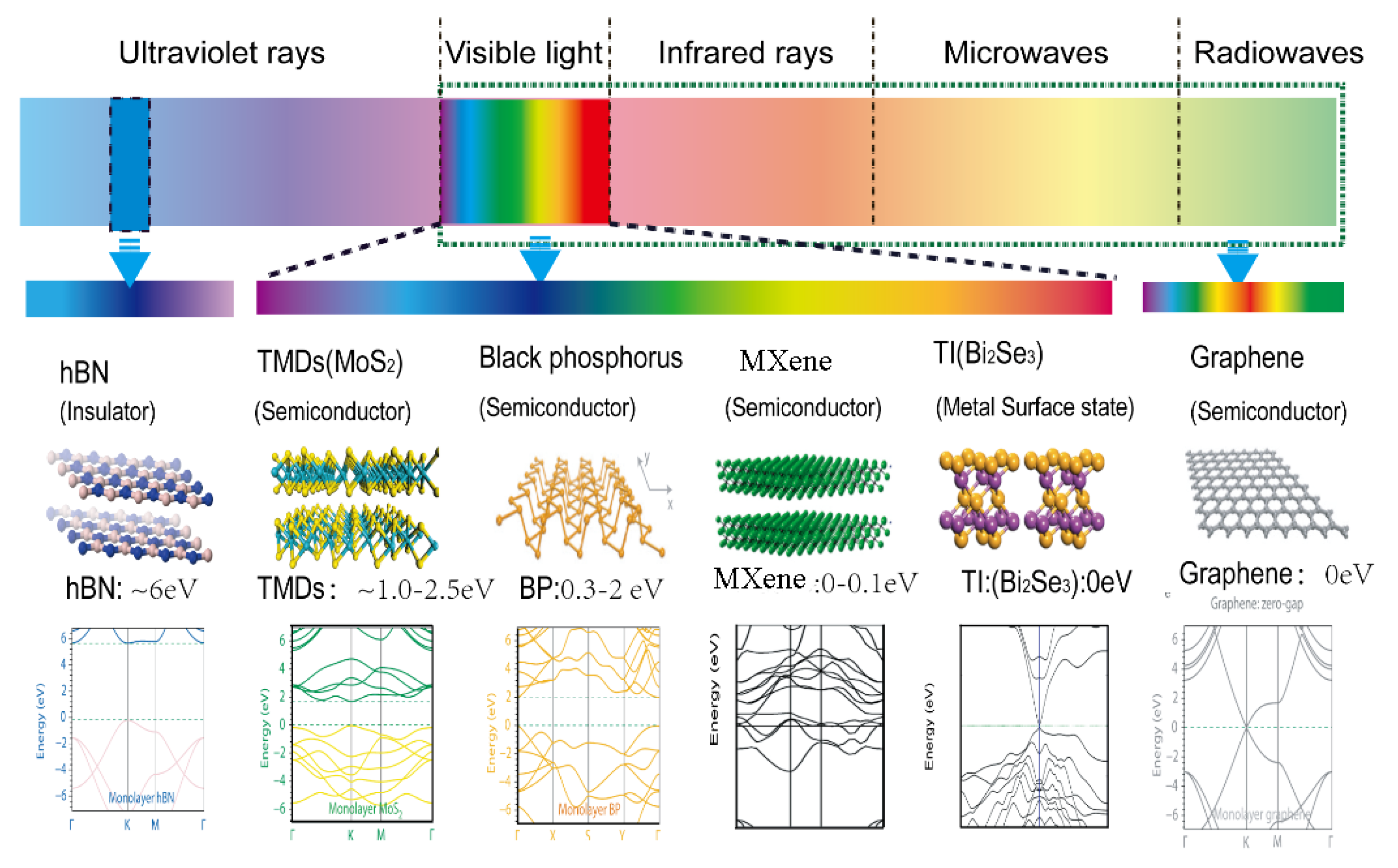

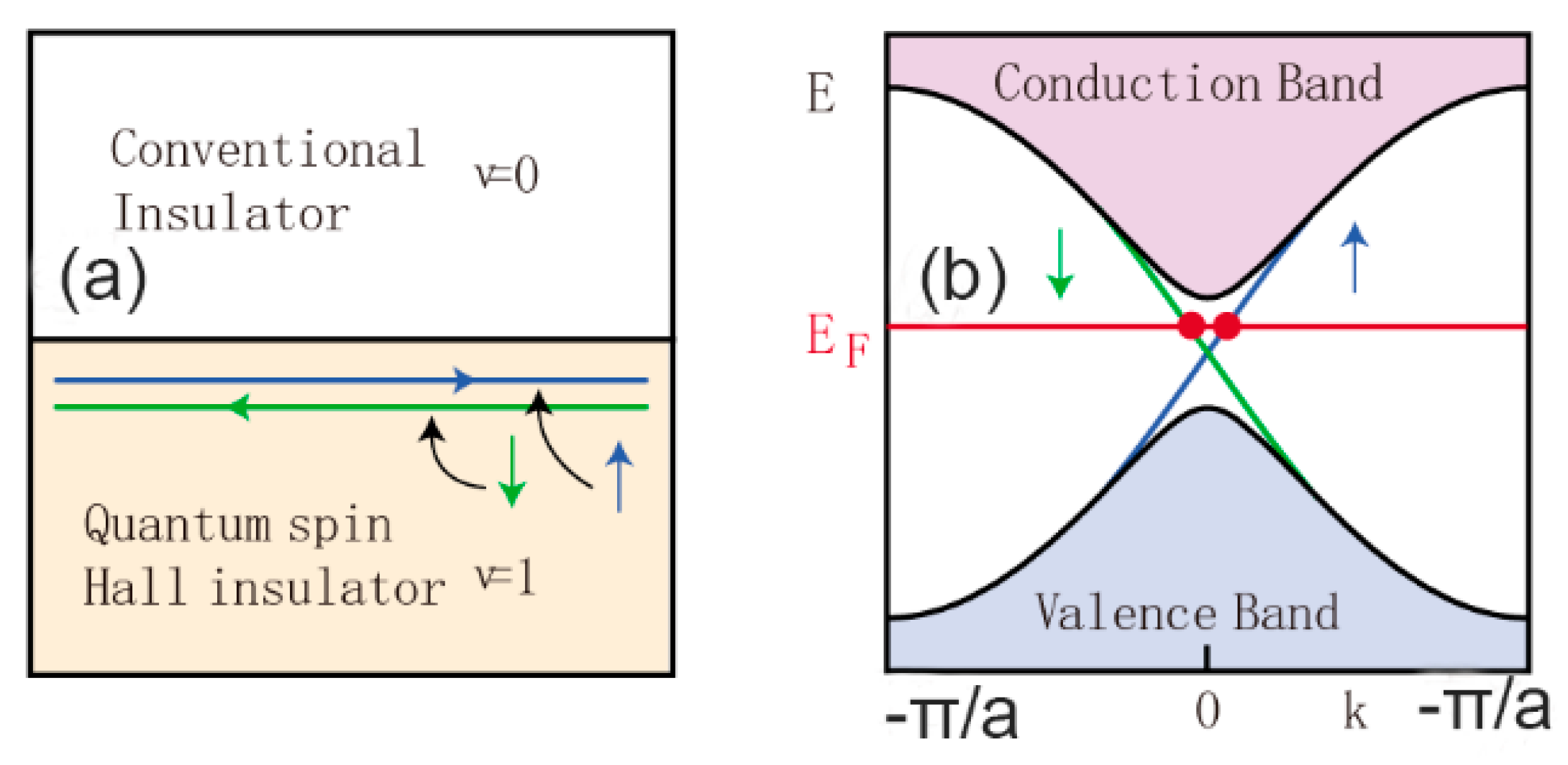


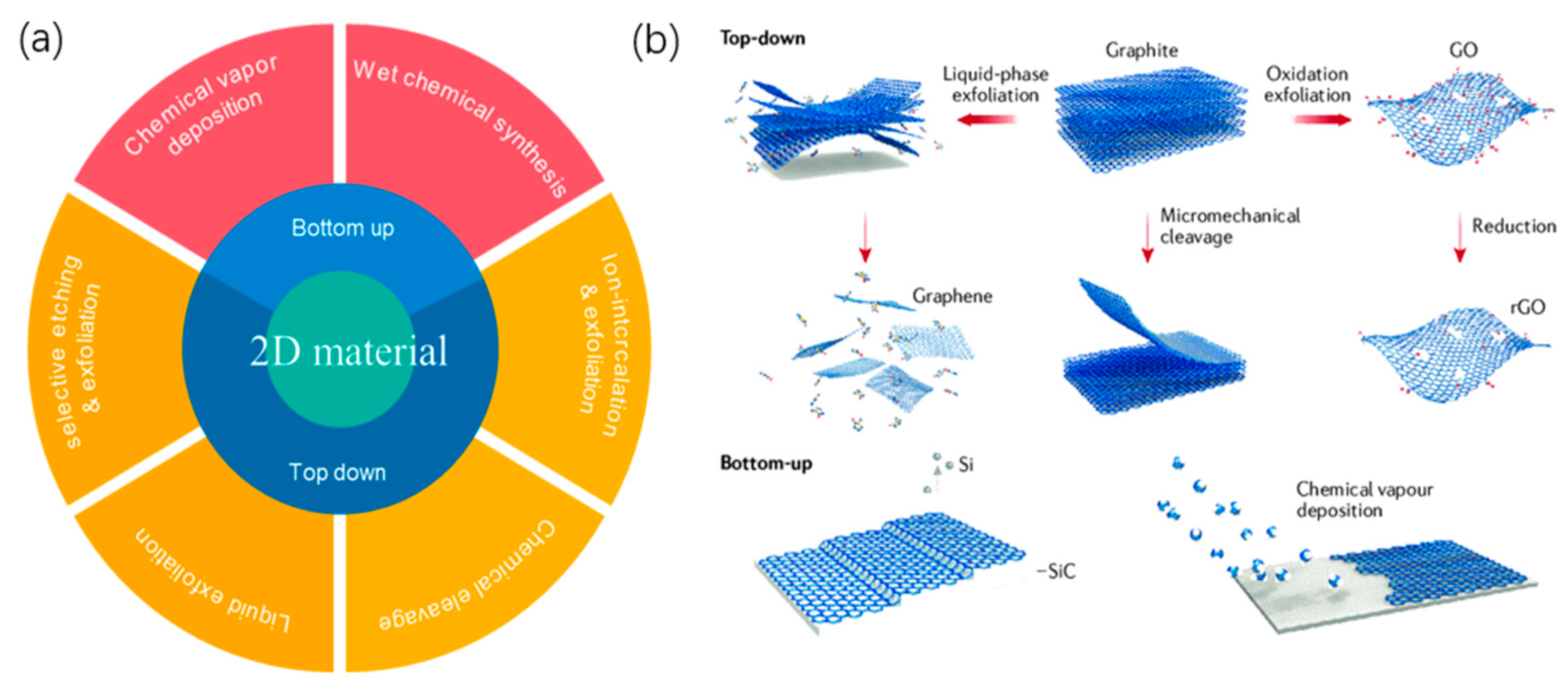

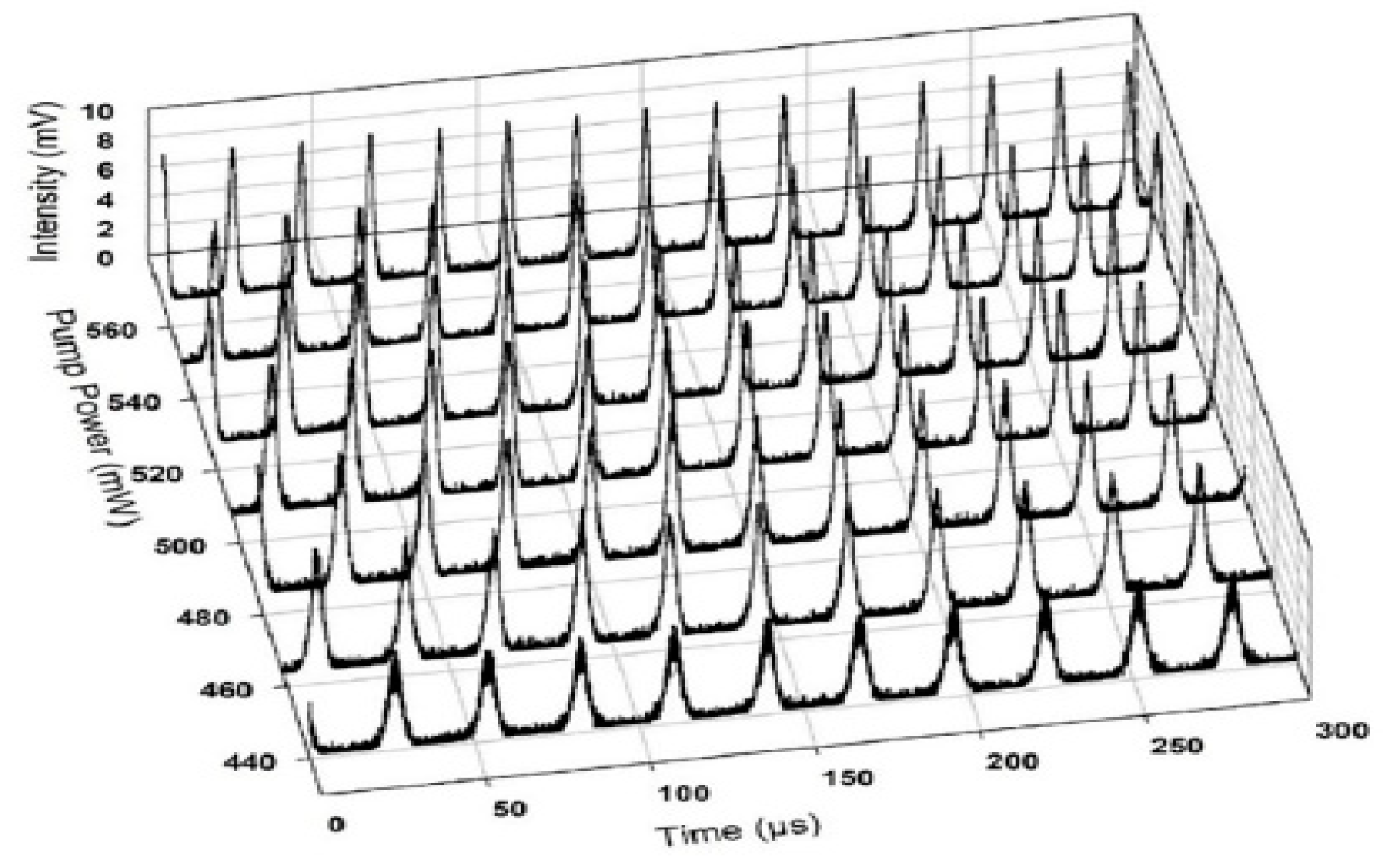
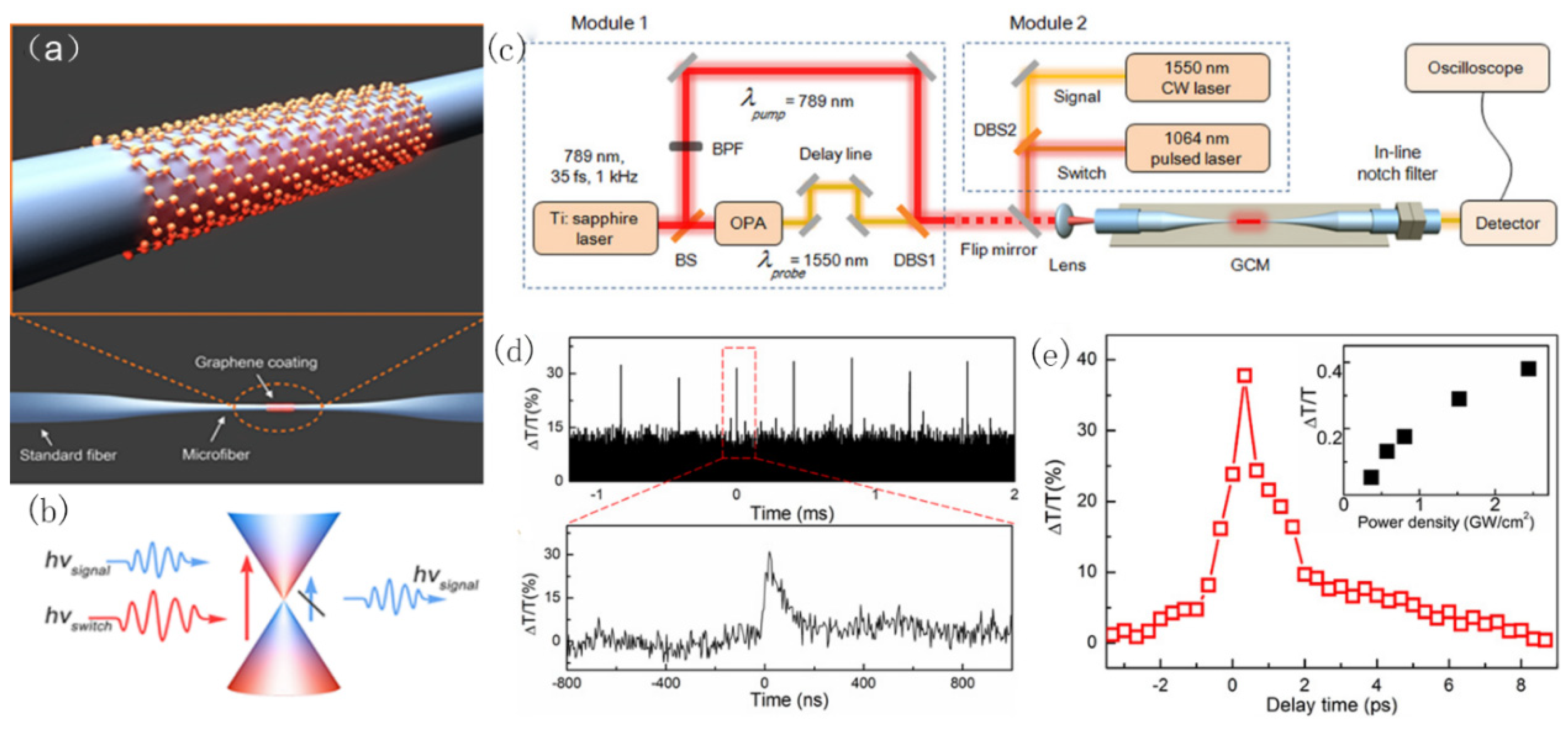
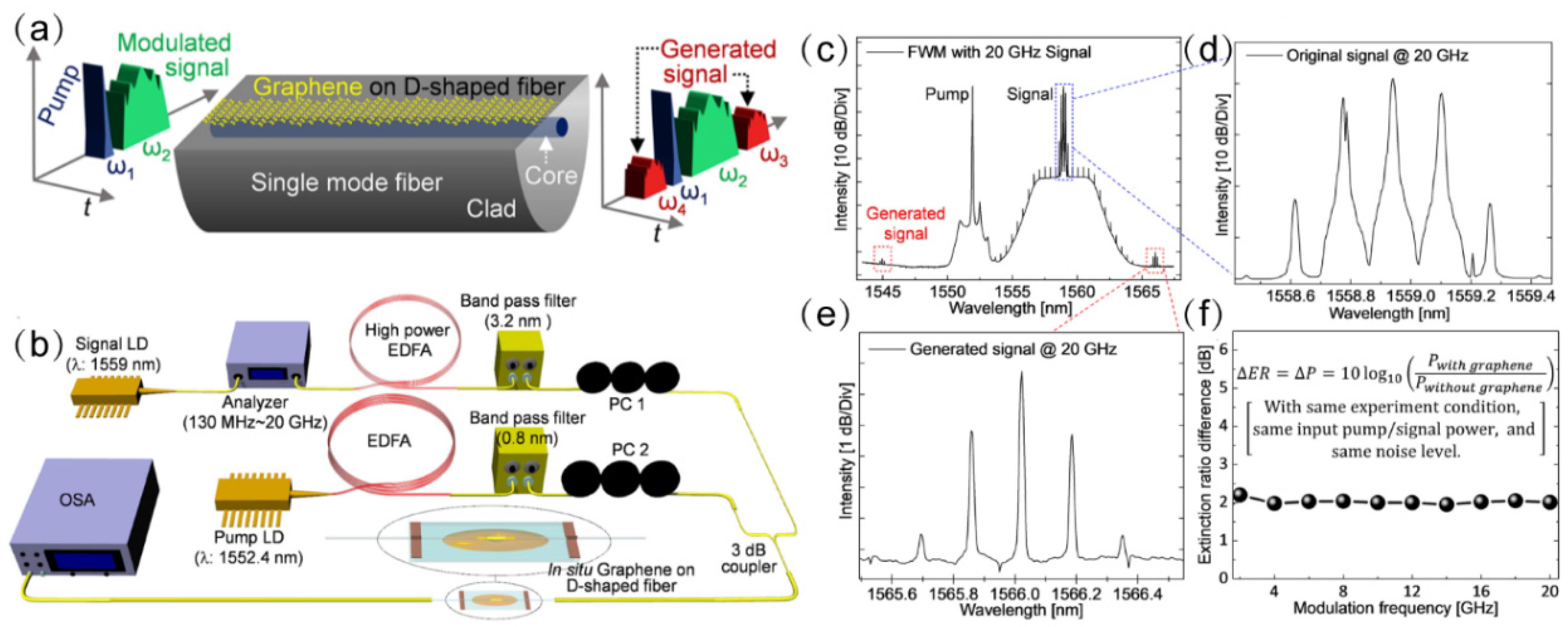
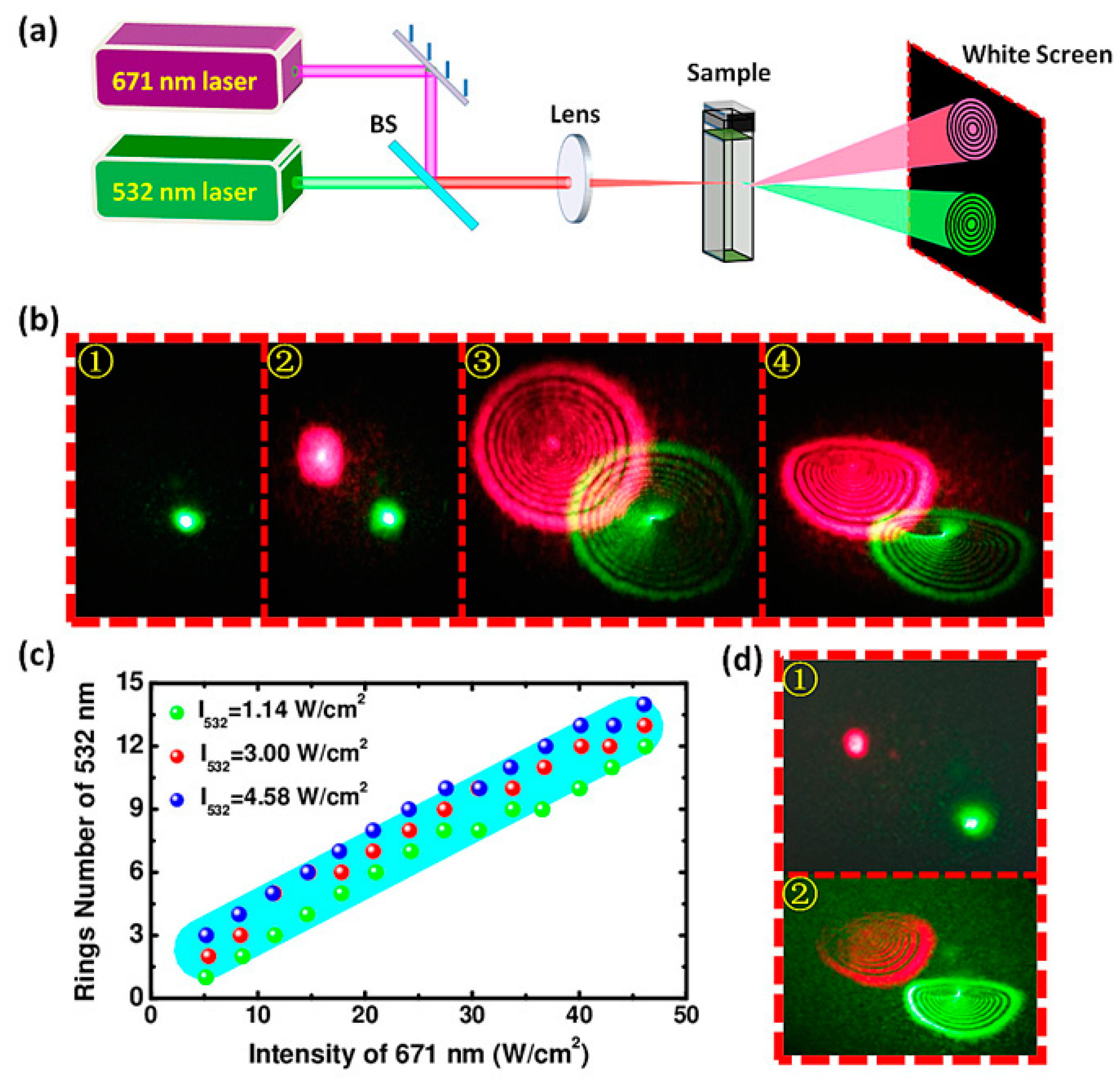
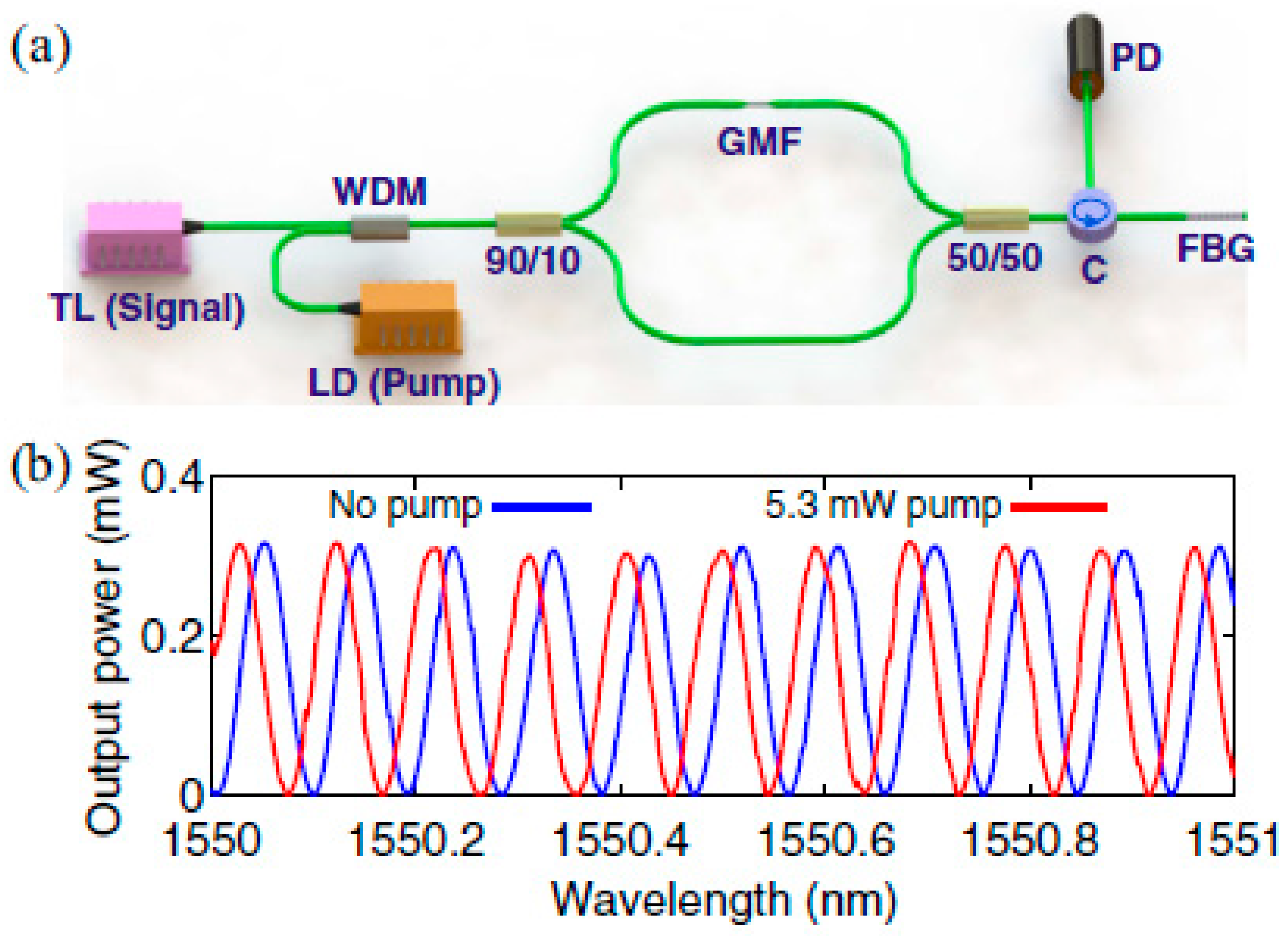
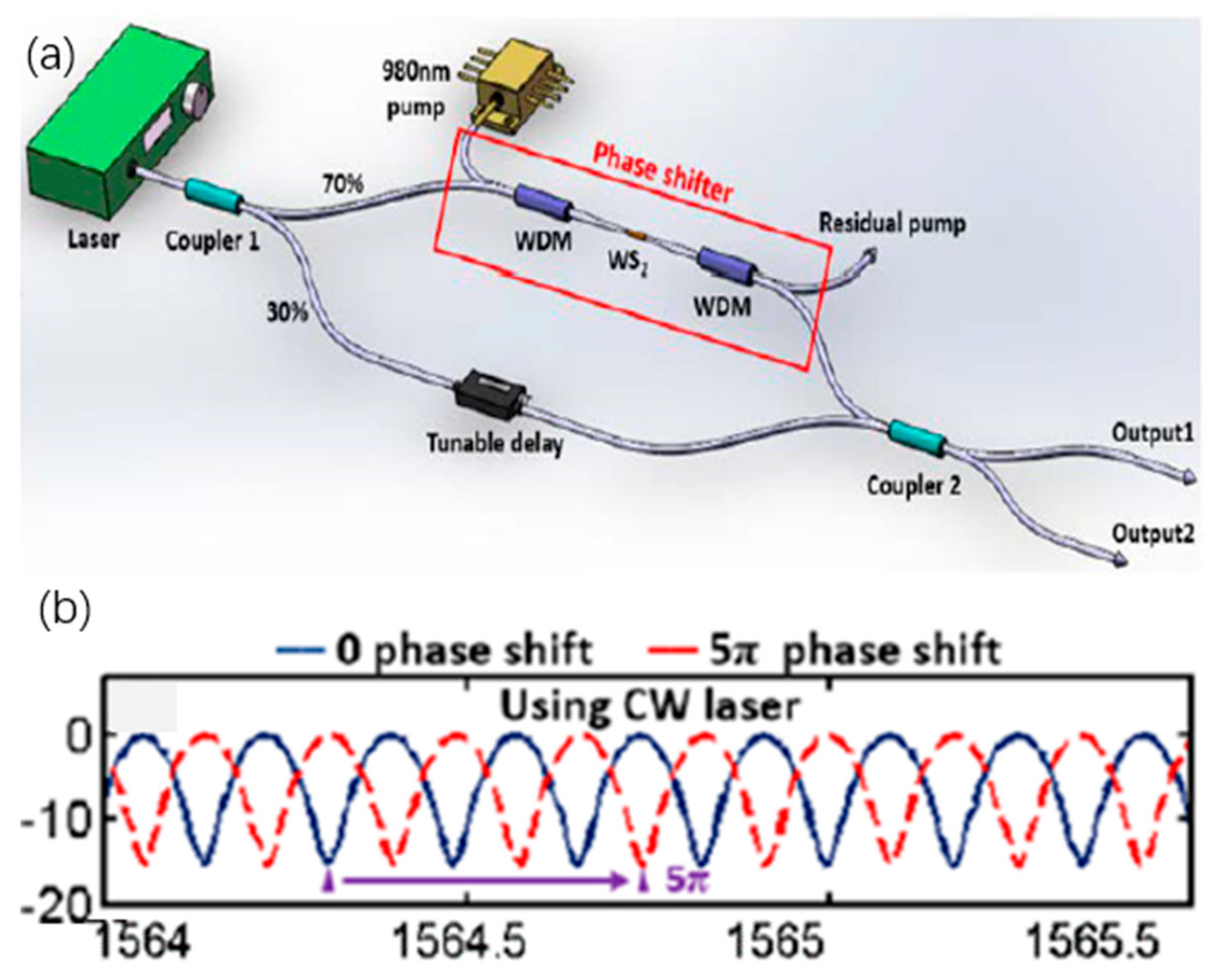
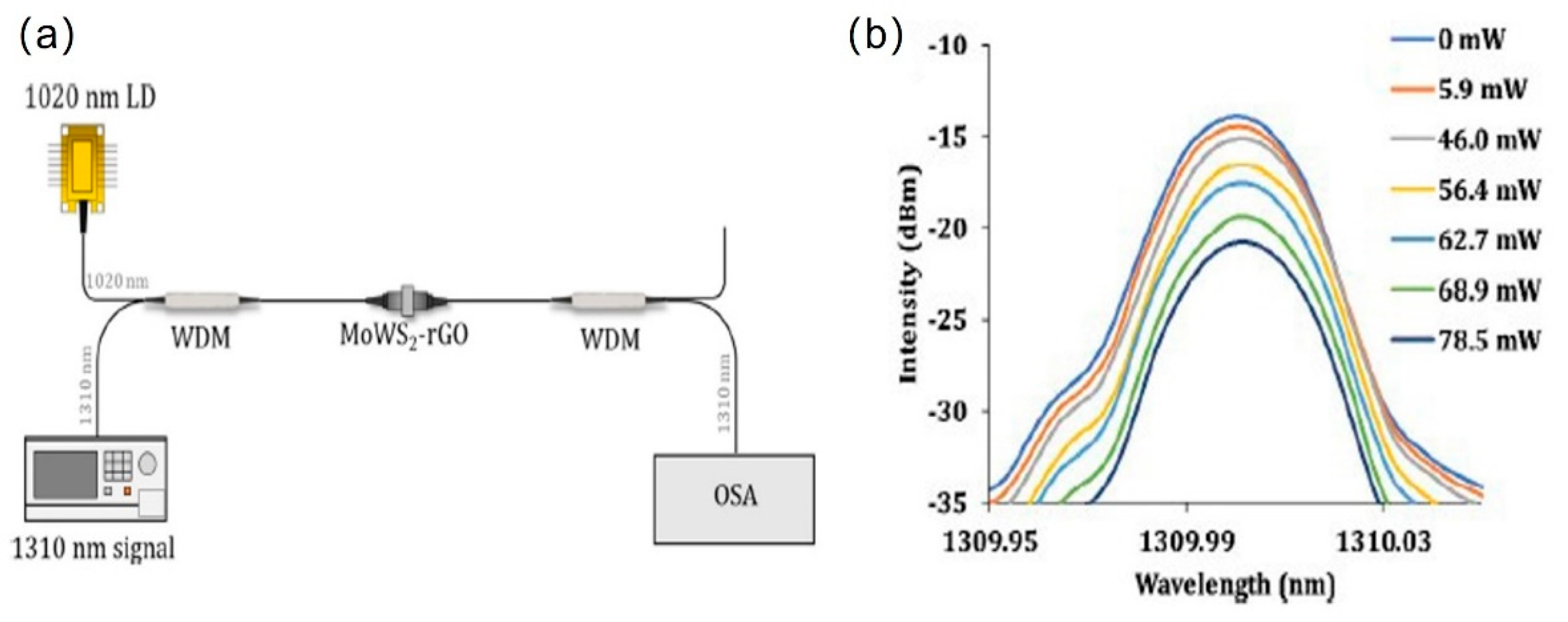
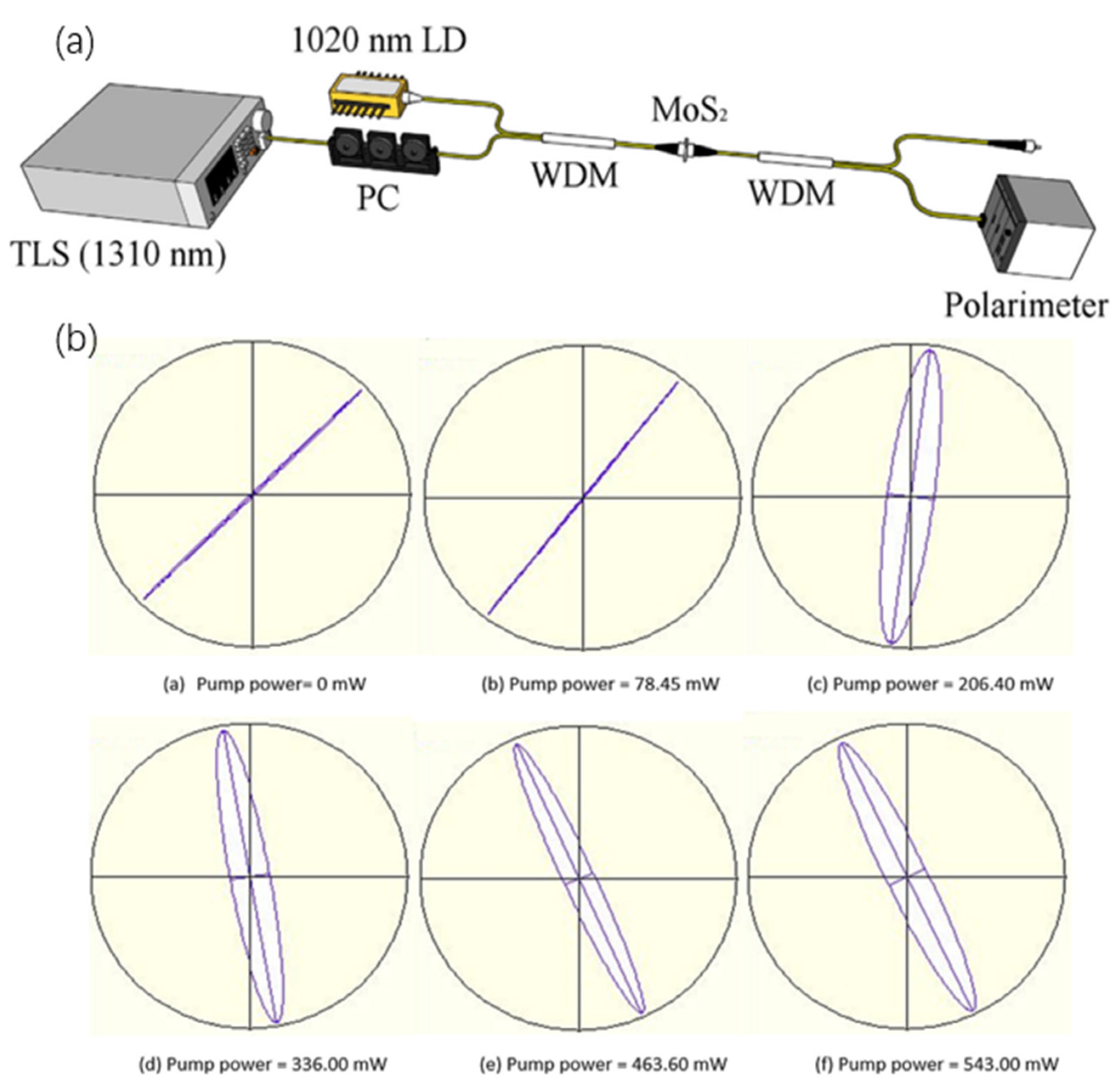
| 1D Material | 2D Materials | 3D Material | |||
|---|---|---|---|---|---|
 |  |  |  |  |  |
Air stable? Yes | Air stable? Yes | Air stable? Yes | Air stable? Yes | Air stable? Yes | Air stable? Yes |
Publisher’s Note: MDPI stays neutral with regard to jurisdictional claims in published maps and institutional affiliations. |
© 2022 by the authors. Licensee MDPI, Basel, Switzerland. This article is an open access article distributed under the terms and conditions of the Creative Commons Attribution (CC BY) license (https://creativecommons.org/licenses/by/4.0/).
Share and Cite
Yang, H.; Wang, Y.; Tiu, Z.C.; Tan, S.J.; Yuan, L.; Zhang, H. All-Optical Modulation Technology Based on 2D Layered Materials. Micromachines 2022, 13, 92. https://doi.org/10.3390/mi13010092
Yang H, Wang Y, Tiu ZC, Tan SJ, Yuan L, Zhang H. All-Optical Modulation Technology Based on 2D Layered Materials. Micromachines. 2022; 13(1):92. https://doi.org/10.3390/mi13010092
Chicago/Turabian StyleYang, Hongyan, Yunzheng Wang, Zian Cheak Tiu, Sin Jin Tan, Libo Yuan, and Han Zhang. 2022. "All-Optical Modulation Technology Based on 2D Layered Materials" Micromachines 13, no. 1: 92. https://doi.org/10.3390/mi13010092
APA StyleYang, H., Wang, Y., Tiu, Z. C., Tan, S. J., Yuan, L., & Zhang, H. (2022). All-Optical Modulation Technology Based on 2D Layered Materials. Micromachines, 13(1), 92. https://doi.org/10.3390/mi13010092







